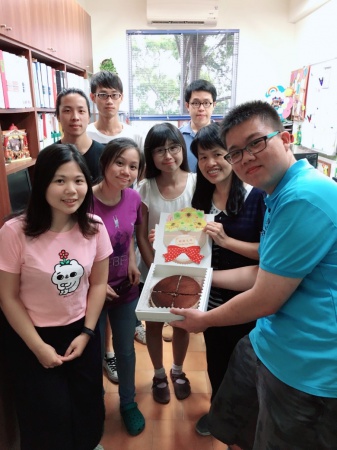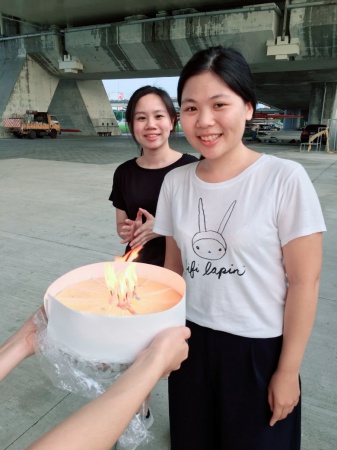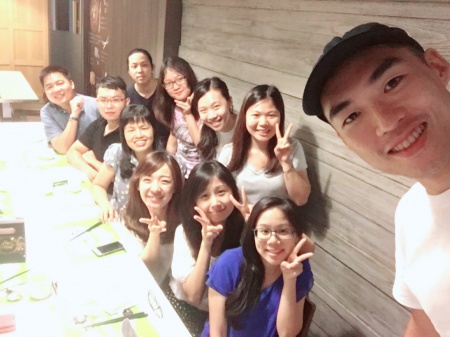
Chung Jiuan Jeng
Ph.D. Professor
Research
Welcome to our lab! We currently have two research directions: (1) channelopathy, (2) signaling mechanisms underlying the neuroinflammation. By understanding the pathophysiological mechanisms of ion channel diseases and the impact of neuroinflammation, we may develop ways to prevent and treat these diseases in the future.
Research Area
- Molecular assembly and gene regulation of ion channels.
- Biosynthesis and trafficking of ion channels.
- Pathophysiology of ion channel diseases.
- Neuroinflammation.
Faculty Profiles
鄭瓊娟教授(兼所長科主任)
Current Position
- Professor/Department of Anatomy and Cell Biology
Education
- Anatomy and Cell Biology, University of California, Los Angeles, USA
- Anatomy and Cell Biology, National Taiwan University, Taiwan
- Physical Therapy, National Taiwan University, Taiwan
Appointments
- Assistant Professor, School of Medicine, Fu-Jen University, Taiwan
- Research scientist, AbGenomics Corp, Taipei, Taiwan
- Postdoctoral fellowship, California Institute of Technology, USA
- Postdoctoral fellowship, University of California, Los Angeles, USA
- Teaching assistant, Department of Anatomy, National Taiwan University, Taiwan
Honors and Awards
- 2018 Excellent Teaching Award, National Yang-Ming University
- 2011 Excellent Teaching Glazed Trophy, College of Medicine,, National Yang-Ming University
- 2008 Excellent Teaching Award, National Yang-Ming University
Research expertise
- Ion channel, Neuroscience
Publications
- C.-H. Hsieh, C.-C. Chou, Y.-C. Fang, P.-H. Hsu, Y.-H. Chiu, C.-S. Yang, G.-M. Jow, C.-Y. Tang, and C.-J. Jeng* (2023) 14-3-3 proteins regulate cullin 7-mediated Eag1 degradation. Cell & Bioscience 13:18. doi: 10.1186/s13578-023-00969-w.
- L.-H. Changa, N.-F. Chib, C.-Y. Chen, Y.-S. Linb, S.-L. Hsub, J.-Y. Tsai, H.-C. Huang, C.-J. Linb, C.-P. Chung, C.-Y. Tung, C.-J. Jeng, Y.-C. Lee, Y.-T. Liu, I.-H. Lee* (2022) Monogenic causes in familial stroke across intracerebral hemorrhage and ischemic stroke subtypes identified by whole exome sequencing. Cellular and Molecular Neurobiology, doi: 10.1007/s10571-022-01315-3.
- Y.-L. Gan, C.-Y. Wang, R.-H. He, P.- C. Hsu, H.- H. Yeh, T.- H. Hsieh, H.- C. Lin, M.- Y. Cheng , C.-J. Jeng, M.-C. Huang* and Y.-H. Lee* (2022) FKBP51 mediates resilience to infammation-induced anxiety through regulation of glutamic acid decarboxylase 65 expression in mouse hippocampus. Journal of Neuroinflammation 19:152. doi:10.1186/s12974-022-02517-8.
- Y.-C. Fang, S.-J. Fu, P.-H. Hsu, P.-T. Chang, J.-J. Huang, Y.-C. Chiu, Y.-F. Liao, G.-M. Jow, C.-Y. Tang*, and C.-J. Jeng* (2021) Identification of MKRN1 as a second E3 ligase for Eag1 potassium channels reveals regulation via differential degradation. Journal of Biological Chemistry 296, 100484.
- C.-T. Hsiao, T.F. Tropea., S.-J. Fu, T.M. Bardakjian, P. Gonzalez-Alegre, B.-W. Soong, C.-Y. Tang*, C.-J. Jeng* (2021) Rare gain-of-function KCND3 variant associated with cerebellar ataxia, parkinsonism, cognitive dysfunction, and brain iron accumulation. International Journal of Molecular Sciences. 22, 8247. doi: 10.3390/ijms22158247.
- G. Zanni*, C.-T. Hsiao, S.-J. Fu, C.-Y. Tang, A. Capuano, L. Bosco, F. Graziola, E. Bellacchio, S.. Servidei., G. Primiano., B.-W. Soong and C.-J. Jeng* (2021) Novel KCND3 variant underlying nonprogressive congenital ataxia or SCA19/22 disrupt Kv4.3 protein expression and K+ currents with variable effects on channel properties. International Journal of Molecular Sciences. 22, 4986. doi: 10.3390/ijms22094986.
- C.-S. Chiang., S.-J. Fu., C.-L. Hsu, C.-J. Jeng, C.-Y. Tang, Y.-S. Huan, S.-C. Tang* (2021) Neuronal exosomes secreted under oxygen-glucose deprivation/reperfusion presenting differentially expressed miRNAs and affecting neuronal survival and neurite outgrowth. NeuroMolecular Medicine. doi: 10.1007/s12017-020-08641-z.
- S.-J. Fu., M.-C. Hu, C.-T. Hsiao, A.-T. Cheng, T.-Y. Chen, C.-J. Jeng*, and C.-Y. Tang* (2021) Regulation of ClC-2 chloride channel proteostasis by molecular chaperones: correction of leukodystrophy-associated defect. International Journal of Molecular Sciences. 22, 5859. doi: 10.3390/ijms22115859.
- S.-J. Fu, M.-C. Hu, Y.-J. Peng, H.-Y. Fang, C.-T. Hsiao, T.-Y. Chen, C.-J. Jeng*, C.-Y. Tang* (2020) CUL4-DDB1-CRBN E3 Ubiquitin Ligase Regulates Proteostasis of ClC-2 Chloride Channels: Implication for Aldosteronism and Leukodystrophy. Cells 9, 1332; doi:10.3390/cells9061332
- C.-J. Jeng, S.-J. Fu, C.-Y. You, Y.-J. Peng, C.-T. Hsiao, T.-Y. Chen, C.-Y. Tang* (2020) Defective gating and proteostasis of human CLC-1 chloride channel: molecular pathophysiology of myotonia congenital. Frontiers in Neurology Vol 11, Article 76; Doi: 10.3389/fneur.2020.00076
- C.-T. Hsiao, S.-J. Fu, Y.-T. Liu, Y.-H. Lu, C.-Y. Zhong, C.-Y. Tang, B.-W. Soong*, C.-J. Jeng* (2019) Novel SCA19/22-associated KCND3 mutations disrupt human KV4.3 protein biosynthesis and channel gating. Human Mutation 40:2088–2107. doi: 10.1002/humu.23865
- Y.-J. Peng, Y.-C. Lee, S.-J. Fu, Y.-C. Chien, Y.-F. Liao, T.-Y. Chen, C.-J. Jeng*, C.-Y. Tang* (2018) FKBP8 enhances protein stability of CLC-1 chloride channel at the plasma membrane. International Journal of Molecular Sciences. 9: 3783, doi:10.3390/ijms19123783
- P.-H. Hsu, Y.-T. Ma, Y.-C. Fang, J.-J. Huang, Y.-L. Gan, P.-T. Chang, G.-M. Jow, C.-Y. Tang*, C.-J. Jeng* (2017) Cullin 7 mediates proteasomal and lysosomal degradations of rat Eag1 potassium channels. Scientific Reports 7:40825, DOI: 10.1038.
- S.-J. Fu, C.-J. Jeng, C.-H. Ma, Y.-J. Peng, C.-M. Lee, Y.-C. Fang, Y.-C. Lee, S.-C. Tang, M.-C. Hu, C.-Y. Tang* (2017) Ubiquitin ligase RNF138 promotes episodic ataxia type 2-associated aberrant degradation of human CaV2.1 (P/Q-type) calcium channels. Journal of Neuroscience 37(9):2485–2503.
- P.-H. Hsu, Y.-C. Chiu, T.-F. Lin, C.-J. Jeng* (2016) Ca2+-binding protein centrin 4 is a novel binding partner of rat Eag1 K+ channels. FEBS Open Bio doi:10.1002/2211-5463.12045.
- Y.-C. Teng, C.-J. Jeng, H.-J. Huang, A. M.-Y. Lin (2015) Role of autophagy in arsenite-induced neurotoxicity: The involvement of alpha-synuclein. Toxicology Letters 233: 239-245.
- T.-F. Lin, G.-M Jow, H.-Y. Fang, S.-J. Fu, H.-H. Wu, M.-M. Chiu, C.-J. Jeng* (2014) The eag domain regulates the voltage-dependent inactivation of rat Eag1 K+ channels. PLoS ONE 9(10): e110423.
- T.-F. Lin, I-W. Lin, S.-C. Chen, H.-H. Wu, C.-S. Yang, H.-Y Fang, M.-M. Chiu, C.-J. Jeng* (2014) The subfamily-specific assembly of Eag and Erg K+ channels is determined by both the amino and the carboxyl recognition domains. Journal of Biological Chemistry 289(33):22815-22834.
- C.-C. Chuang, G.-M. Jow, H.-M. Lin, Y.-H. Weng, J.-H. Hu, Y.-J. Peng, Y.-C. Chiu, M.-M. Chiu, C.-J. Jeng* (2014) The punctate localization of rat Eag1 K+ channels. BMC Neuroscience 15:23.
- 20. C.-K. Liao, C.-J. Jeng, H.-S. Wang, S.-H. Wang, J.C. Wu (2013) Lipopolysaccharide induces degradation of connexin43 in rat astrocytes via the ubiquitin-proteasome proteolytic pathway. PLoS ONE 8(11): e79350.
- P.-H. Hsu, S.-C. Miawa, C.-C. Chuang, P.-Y. Chang, S.-J. Fu, G.-M. Jow, M.-M. Chiu, C.-J. Jeng* (2012) 14-3-3theta is a Binding Partner of Rat Eag1 potassium Channels. PLoS ONE 7(7): e41203.
- S.-H. Yang, C.-C. Liao, Y. Chen, J.-P. Syu, C.-J. Jeng*, S.-M. Wang (2012) Daidzein induces neuritogenesis in DRG neuronal cultures. Journal of Biomedical Science 19:80.
- I.-H. Chen, J.-H. Hu, G.-M. Jow, C.-C. Chuang, T.-T. Lee, D.-C. Liu, C.-J. Jeng* (2011) The distal end of carboxyl-terminus is not essential for the assembly of rat Eag1 potassium channels. Journal of Biological Chemistry 286(31) 27183–27196.
- S.-H. Yang; C.-J. Jeng, C-H Chen, Y. Chen, Y.-C. Chen, and S.-M. Wang* (2011) Schisandrin enhances dendrite outgrowth and synaptogenesis in primary cultured hippocampal neurons. Journal of the Science of Food and Agriculture 91(4): 694–702.
Invited Presentations
- Proteostatic mechanism of neuronal K+ channels: Pathophysiological implications in neurological diseases, 國衛院細胞及系統醫學研究所, 7/14/2022.
- Molecular basis and pathological significance of K+ channel degradation, 成功大學醫學院細胞生物與解剖學研究所, 10/27/2021.
- Protein biosynthesis mechanisms of neuronal K+ channel degradation, 成功大學醫學院細胞生物與解剖學研究所, 5/1/2019.
- Proteostatic mechanism of Eag1 potassium channel, 29th Ion Channel Meeting, CANAUX IONIQUES, Sète, France, 9/10/2018.
- Regulation of ether-à-go-go potassium channel expression by RING E3 ubiquitin ligases and 14-3-3 proteins, 政治大學神經科學研究所, 5/22/2018.
- Regulation of ether-à-go-go potassium channel expression by ring E3 ubiquitin ligases, The 33th Joint Annual Conference of Biomedical Science, Taipei, Taiwan, 3/24/2018.
- Protein interaction mechanisms of Eag potassium channels, Internal Symposium in Osaka University, Osaka, Japan, 8/3/2017.
- Protein targeting and molecular assembly of ether-à-go-go potassium channels, The 31th Joint Annual Conference of Biomedical Science, Taipei, Taiwan, 3/26/2016.
- Protein interaction mechanisms of ether-à-go-go potassium channels, 國防大學醫學院生物及解剖學研究所, 12/8/2016.
- Molecular assembly of ether-à-go-go potassium channels, 陽明大學生理學研究所, 3/19/2015.
- Molecular assembly and protein association of ether-à-go-go potassium channels, 高雄榮民總醫院 教研部, 10/31/2014.
- Molecular assembly and protein association of Eag K+ channels, 生科院-週三中午有約, 6/5/2013.
- Structural and functional characterization of ether-à-go-go potassium channel, 輔仁大學醫學院基礎醫學研究所, 11/29/2012.
- Molecular assembly and protein association of neuronal potassium channels, The 26th Joint Annual Conference of Biomedical Sciences, 3/20/2011.

























